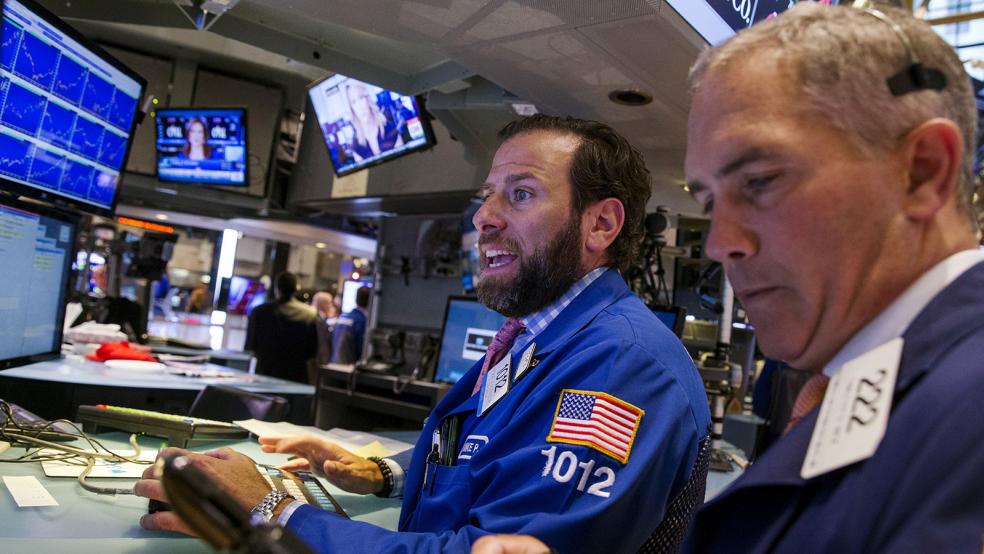The Dow Jones Industrial Average continues to climb toward the 20,000 level, helped by the rout underway in bonds as interest rates soar. The yield on 10-year U.S. Treasuries jumped above 2.5 percent on Monday for the first time in more than two years.
While lower bond prices are driving capital into stocks, they could also be sowing the seeds of the stock rally's eventual demise. The U.S. dollar’s surge could be the proverbial "canary in the coal mine" that something's amiss.
Related: Stocks Are Soaring, but This Market Indicator Is Flashing Like It's 1929
Let's be clear: With investors still in their post-election honeymoon period, stocks will likely continue to drift higher through the end of the year. Trump isn't president yet. Market seasonality is strong. And holiday cheer is encouraging feelings of hopefulness.
But risks are on the rise, reflected in the recent upward movement in the CBOE Volatility Index (VIX) as Wall Street insiders grow wary of the market's extension above its medium-term trend measures — suggesting the uptrend is growing increasingly vulnerable to a pullback.
Consider, for instance, that the Dow is currently more than 6 percent above its 50-day moving average — a measure of the intermediate-term trend. That's rare: Since 1985, on any given day the Dow is typically just 0.9 percent above its 50-day average. Breadth remains a concern as well, with just about two-thirds percent of S&P 500 stocks in uptrends.
Heading into next year, as the upward drift in interest rates continues, investors will likely begin to consider the downsides of the bloodbath in bonds, including higher mortgage rates, pricier auto loans and lowered consumer confidence. Already, there is evidence that the rise in 30-year mortgage rates from an average of 3.6 percent before the election to above 4 percent now is trimming loan demand, with the Mortgage Bankers Association forecasting a 46 percent drop in refinancing in 2017.
Related: Global Stocks Forecast to Rise Next Year, but Face Risks A-Plenty
Moreover, Goldman Sachs economists also noted last week that any fiscal stimulus from the incoming Trump administration is unlikely to hit until early 2018. The legislative process takes time to work, after all. We're going to get the negatives of Trump's fiscal plans first (higher rates) before the benefits (lower taxes, increased infrastructure spending).
Wall Street analysts are also warning that higher interest rates will eventually start weighing on equity valuations as well, since those rates will lower the value of future earnings and negatively impact profitability by raising interest costs. Analysts at Societe Generale put the danger zone for rates at 2.6 percent. Goldman Sachs puts it at 2.75 percent. Above these levels, stocks valuations could suffer.
With the Fed's next policy meeting wrapping up Dec. 14, economists surveyed by The Wall Street Journal noted an increase in rate expectations, with respondents seeing the Fed policy rate at 1.26 percent on average by December 2017, representing four rate hikes from current levels.\
Related: Hawkish Fed a Potential Speed Bump for Stock Bulls
Translation: Interest rates will soon reach the pain point. When that happens, the speculative fever that's lifted stocks since early November could quickly break.
Another point of pain has been the surge in the U.S. dollar. Not only does the strengthening of the greenback increase the cost for emerging market companies rolling over some $10 trillion in offshore dollar-denominated debt (the reason for the selloff in emerging markets in the summer of 2015), but it also tightens financial conditions for the rest of the world — even in places like China, where easier monetary conditions are currently needed
As a result, no less than the Bank for International Settlements recently warned that the U.S. dollar is the new best indicator for global financial risk. When it rises dramatically, it's a sign of danger.
To put it plainly: If interest rates and the dollar keep rising, stocks won't be able to follow for very long.







